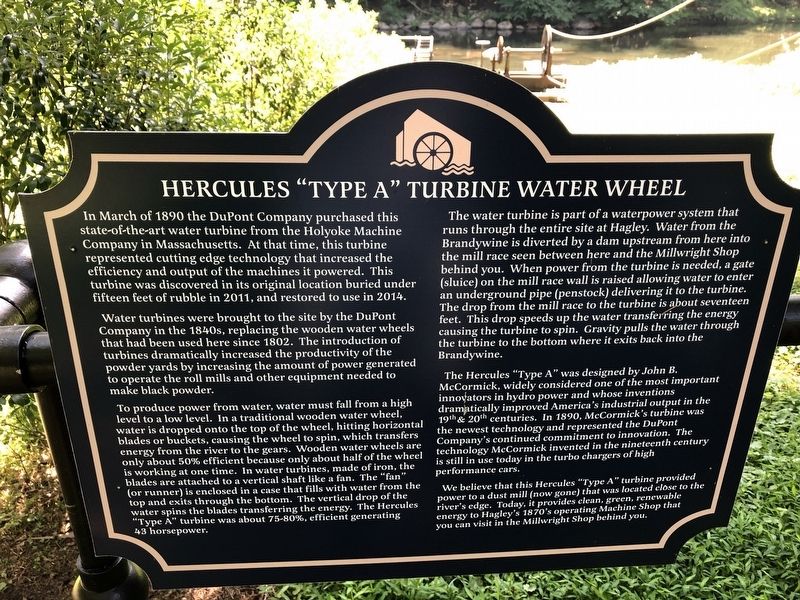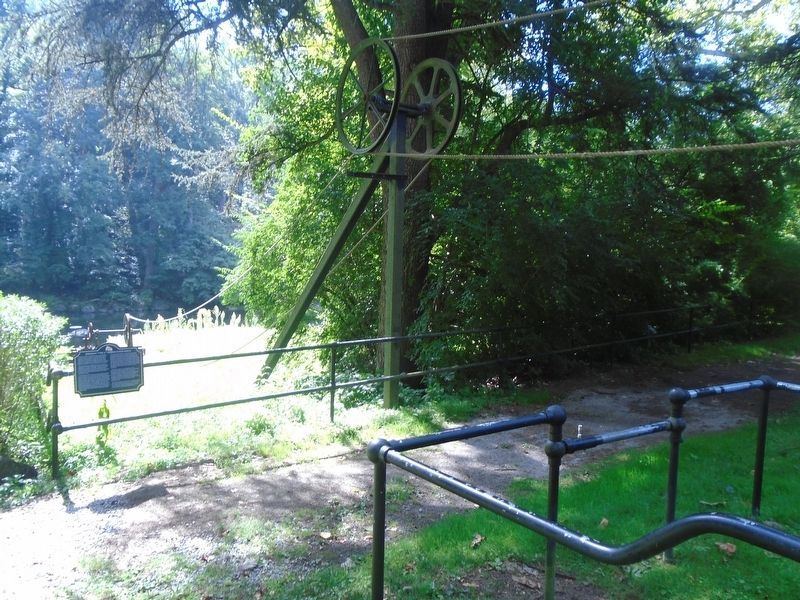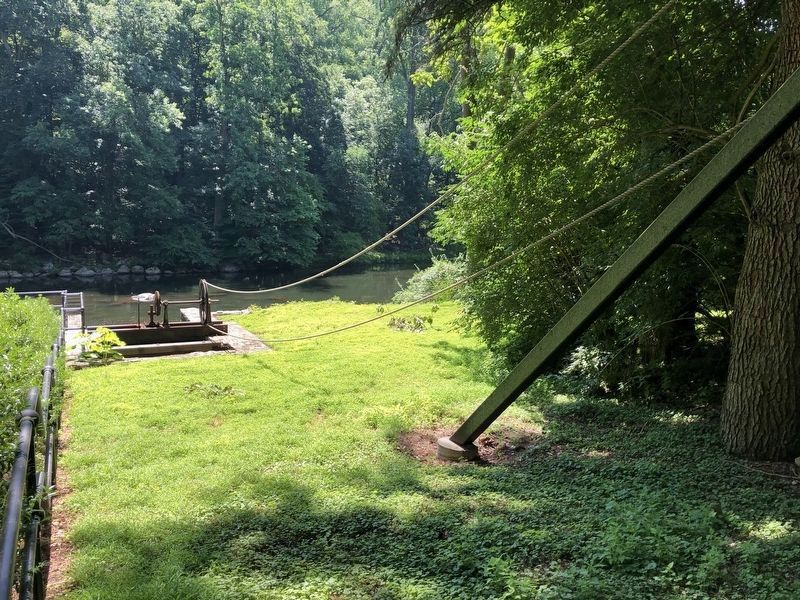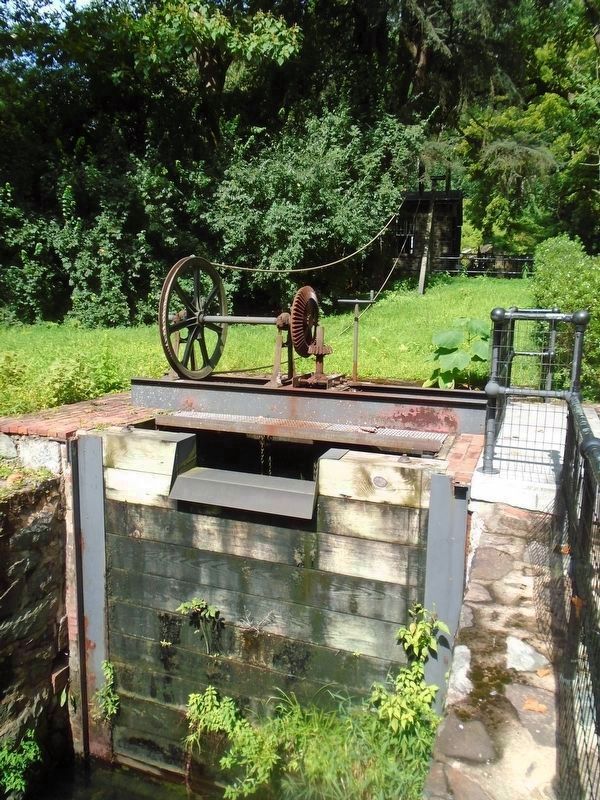Hagley Museum near Wilmington in New Castle County, Delaware — The American Northeast (Mid-Atlantic)
Hercules "Type A" Turbine Water Wheel
— Eleutherian Mills Hagley Yard —
Water turbines were brought to the site by the DuPont Company in the 1840s, replacing the wooden water wheels that had been used here since 1802. The introduction of turbines dramatically increased the productivity of the powder yards by increasing the amount of power generated to operate the roll mills and other equipment needed to make black powder.
To produce power from water, water must fall from a high level to a low level. In a traditional wooden water wheel, water is dropped onto the top of the wheel, hitting horizontal blades or buckets, causing the wheel to spin, which transfers energy from the river to the gears. Wooden water wheels are only about 50% efficient because only about half of the wheel is working at one time. In water turbines, made of iron, the blades are attached to a vertical shaft like a fan. The "fan" (or runner) is enclosed in a case that fills with water from the top and exits through the bottom. The vertical drop of the water spins the blades transferring the energy. The Hercules "Type A" turbine was about 75-80%, efficient generating 43 horsepower.
The water turbine is part of a waterpower system that runs through the entire site at Hagley. Water from the Brandywine is diverted by a dam upstream from here into the mill race seen between here and the Millwright Shop behind you. When power from the turbine is needed, a gate (sluice) on the mill race wall is raised allowing water to enter an underground pipe (penstock) delivering it to the turbine. The drop from the mill race to the turbine is about seventeen feet. This drop speeds up the water transferring the energy causing the turbine to spin. Gravity pulls the water through the turbine to the bottom where it exits back into the Brandywine.
The Hercules "Type A" was designed by John B. McCormick, widely considered one of the most important innovators in hydro power and whose inventions dramatically improved America's industrial output in the 19th & 20th centuries. In 1890, McCormick’s turbine was the newest technology and represented the DuPont Company's continued commitment to innovation. The technology McCormick invented in the nineteenth century is still in use today in the turbo chargers of high performance cars.
We believe that this Hercules "Type A" turbine provided power to a dust mill
(now gone) that was located close to the river's edge. Today, it provides clean, green, renewable energy to Hagley's 1870's operating Machine Shop that you can visit in the Millwright Shop behind you.
Erected by Hagley Museum.
Topics. This historical marker is listed in these topic lists: Industry & Commerce • Waterways & Vessels.
Location. 39° 46.737′ N, 75° 34.385′ W. Marker is near Wilmington, Delaware, in New Castle County. It is in Hagley Museum. Marker is on Hagley Creek Road, on the right when traveling north. The marker is located on the grounds of the Hagley Museum. Touch for map. Marker is at or near this postal address: 200 Hagley Creek Road, Wilmington DE 19807, United States of America. Touch for directions.
Other nearby markers. At least 8 other markers are within walking distance of this marker. The Powdermen (a few steps from this marker); Stone Boat (within shouting distance of this marker); Stone Quarry (within shouting distance of this marker); Hagley Rocks! (within shouting distance of this marker); Millwright Shop (within shouting distance of this marker); Site A: Millwright Shop (within shouting distance of this marker); The Evolution of the Incorporating Process (about 300 feet away, measured in a direct line); J.E. Rhoads & Sons of Delaware Tanbark Stone (about 300 feet away). Touch for a list and map of all markers in Wilmington.
Also see . . .
1. Turbine Water-Wheel Tests and Power Tables (Horton, USGS, 1906). (Submitted on September 2, 2023, by William Fischer, Jr. of Scranton, Pennsylvania.)
2. Hagley Museum and Library. (Submitted on September 2, 2023, by William Fischer, Jr. of Scranton, Pennsylvania.)
Credits. This page was last revised on February 11, 2024. It was originally submitted on March 17, 2022, by Pete Skillman of Townsend, Delaware. This page has been viewed 352 times since then and 68 times this year. Photos: 1. submitted on March 17, 2022, by Pete Skillman of Townsend, Delaware. 2. submitted on September 2, 2023, by William Fischer, Jr. of Scranton, Pennsylvania. 3. submitted on March 17, 2022, by Pete Skillman of Townsend, Delaware. 4. submitted on September 2, 2023, by William Fischer, Jr. of Scranton, Pennsylvania. • J. Makali Bruton was the editor who published this page.



